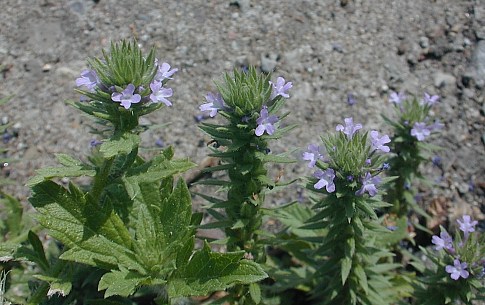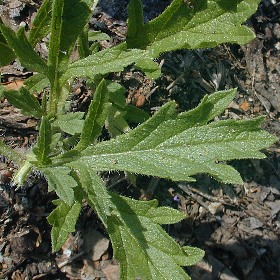Description: This plant is a summer annual or short-lived perennial that branches at the base to form multiple stems. It is only about ½–¾' tall because the stems sprawl across the ground, often forming a circular or semi-circular mat of leaves and stems in open areas. The stems are about ½–1½' in length and more or less 4-angled. They are thinly to moderately covered with long white spreading hairs. The opposite leaves are up to 3" long and 1" across. The lower leaves are sharply divided into 3 primary lobes consisting of a large terminal lobe and 2 side lobes that are much smaller. These primary lobes are themselves divided into secondary lobes, or they may have a few large blunt teeth along their margins. The terminal lobe has a wedge-shaped bottom and tapers to a blunt tip. The side lobes are narrow. The upper leaves lack the side lobes and are a little smaller in size, otherwise they are shaped similarly to the lower leaves. The lower surface and margins of these leaves have scattered white hairs, while their upper surface is less hairy or nearly glabrous.

The stems
terminate in dense spikes of small flowers. These spikes are up to 6"
in length and at least 2/3" (16 mm.) across because of the large
bracts. The
flowers bloom near the apex of each spike where the new growth occurs.
Each flower is about 1/8" (3 mm.) across, consisting of a light blue or
light
purple corolla. This corolla is narrow and tubular at the base, but
flares outward into 5 rounded lobes. The throat of each flower is white
or greenish white. The small narrow calyx is usually a darker shade of
the flower and is rather inconspicuous. Underneath each flower, there
is a single large bract that is lanceolate to linear, with an abundance
of white hair on its underside and margins. The blooming period usually
occurs during the summer and early fall, and lasts about 2-3 months for
a colony of plants. Each flower is replaced by a small hairy capsule
containing 4 nutlets. Each nutlet has an oblong rectangular shape with
a reticulated outer surface. The root system consists of a taproot.
This plant spreads by reseeding itself.
Cultivation:
This plant prefers full sunlight, rather dry conditions, and a barren
soil that is sandy, gravelly, or rocky. During a bad drought, some of
the lower leaves or entire stems may wither away. This plant withstands
foot traffic to some extent.

Range & Habitat:
The native Prostrate Vervain occurs in most areas of Illinois, except
many
counties in south-central section of the state, where it is rare or
absent (see Distribution
Map). Elsewhere, this species is occasional to locally
common. Habitats include upland areas of sand prairies, gravel
prairies, barnyards and pastures, cracks in sidewalks and driveways,
and dry sunny waste areas where sand, gravel, or rocky material is
abundant. This species is more common in disturbed areas of cities
where there is evidence of a decaying infrastructure. It is a member of
an ecologically significant group of plants that pioneer in badly
degraded areas – the first step in restoring the productivity of the
land.
Faunal Associations:
The nectar of the flowers attracts primarily small bees, including Lasioglossum
tegularis (Halictid bee sp.) and Calliopsis
andreniformis (dagger bee sp.). Small butterflies and
skippers may visit the flowers for nectar as well. The foliage is eaten
by the caterpillars of Autographa precationis
(Common Looper Moth) and Crambodes talidiformis
(Verbena Moth). The seeds are a minor source of food to various birds,
including the Mourning Dove, Cardinal, Slate-Colored Junco, and various
native sparrows. The hairy leaves are bitter-tasting and rarely eaten
by mammalian herbivores, although the Cottontail Rabbit may nibble on
the foliage when little else is available.
Photographic Location:
The cracks of a little-used paved driveway in Urbana, Illinois.
Comments:
Prostrate Vervain is a weedy little plant that is often overlooked by
passersby. The foliage is rather coarse in appearance and the flowers
are quite small in size. It is a fine example of a plant that can
survive in the harsh conditions of cities, including high temperatures
near pavement, trampling underfoot and motor vehicle traffic, air
pollution, summer drought, and poor soil lacking organic material. This
species can be distinguished from other vervains by its prostrate habit
and thick spikes of flowers (at least 2/3" or 16 mm. across). Other
vervains have
an erect habit, with the exception of Verbena angustifolia
(Narrow-Leaved Vervain), which has a tendency to sprawl. However, the
slender spikes of this species are less than ½" across and its flowers
are usually white.